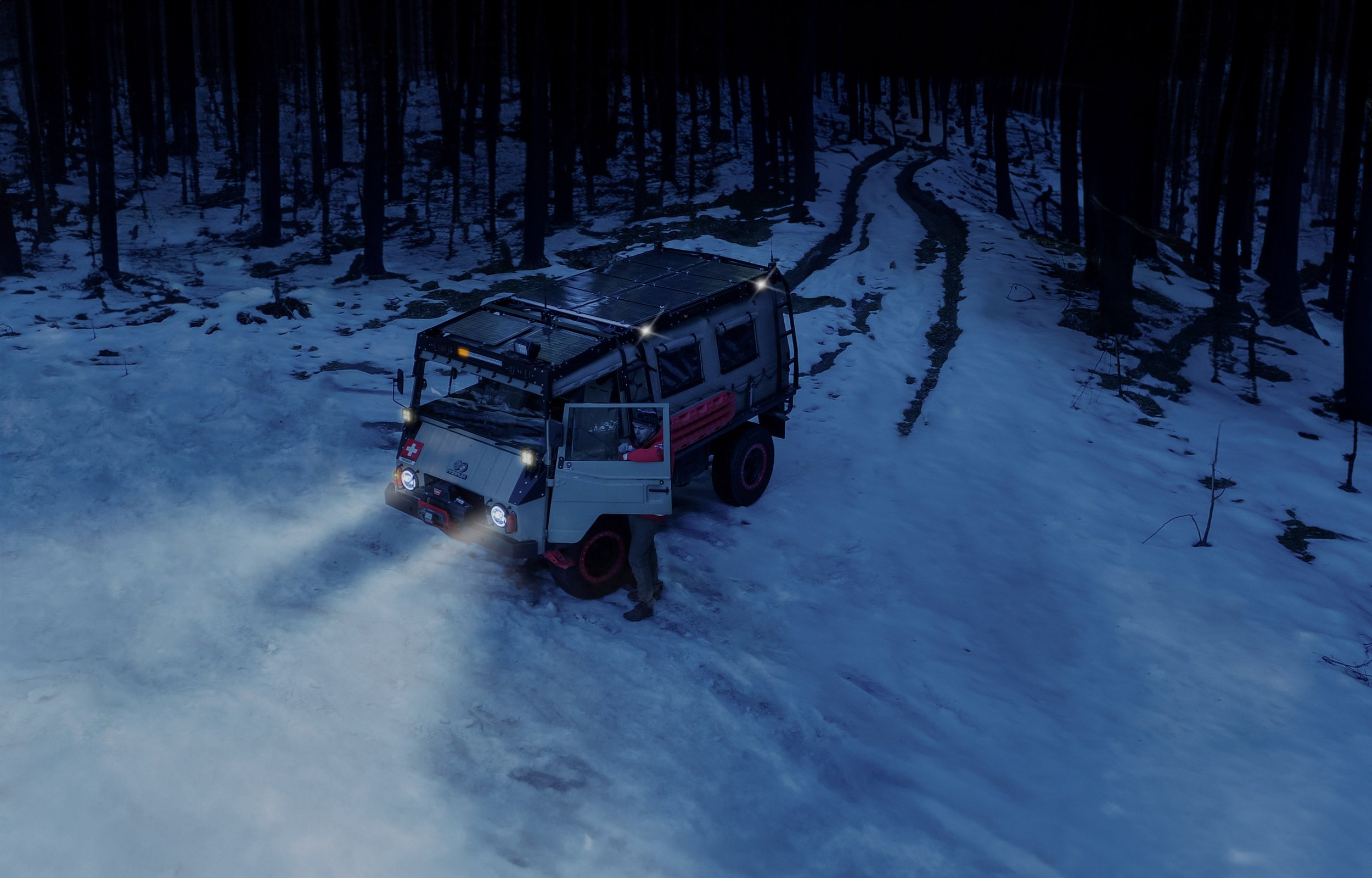Fueling Search & Rescue missions with a Solar-Powered Pinzgauer
Branden “Ben” Powell has been a Search and Rescue volunteer in King County, Washington State, for many years. He started out going on missions in his Jeep Wrangler, and although it had the capability of handling the off-road needs of Search and Rescue, passenger and storage space was limited. With many missions leading deep into the backcountry, the need to carry more people and equipment became apparent.
The Perfect SAR Vehicle was Discovered
After researching alternative vehicle options for over a year, Ben stumbled upon the Pinzgauer, an Austrian-built army transport vehicle. Rugged, overbuilt, yet simple to work on in the field, it was the perfect vehicle for Search and Rescue.
SARPINZ® has led hundreds of missions since Ben converted the Pinzgauer into the ultimate SAR vehicle. Having the peace of mind that this reliable, purpose-built vehicle won’t contribute to the problems it’s designed to help with is invaluable. One of the ways that SARPINZ® has been able to do this is by utilizing solar power to operate onboard equipment needed to support successful missions.
In October 2018, XPLOR Power solar modules were installed on SARPINZ®. We were curious how things were holding up years later, so we chatted with Ben to see how the XPLOR solar modules had performed since their installation and if efficiency was still the same.
Read on to learn how XPLOR panels performed over the years under the demanding conditions of a SAR vehicle’s use.
Rugged Tough Solar Panels for Rugged Tough Missions
XPLOR: “Why did you choose XPLOR solar modules?”
Ben: “Much like SARPINZ® met all of my needs for a capable, reliable vehicle, XPLOR modules met my needs for rugged solar panels that will generate power efficiently under the varying weather and terrain conditions of the Pacific Northwest.
“Since SARPINZ® is used in Search & Rescue, I need the solar panels to be dependable, despite using them in harsh conditions and not being able to take time to stop and clean or care for them.”
Bypass diodes: the benefit you didn’t know you needed
“The bypass diodes per cell that XPLOR uses put their solar modules ahead of other brands. That was a feature I didn’t know existed, but I knew its value immediately upon discovery. Given that I’m often in areas with snow, leaves, branches, and more, my panels were definitely not going to be spotless.
“With other panels, I learned that it didn’t take much blockage to stop the entire panel from collecting solar energy, rendering it effectively useless. With XPLOR panels, if a panel has a partial blockage, only the blocked cell stops producing, and I still benefit from all the others. That’s a game-changer for my application.”
CIGS technology was made for the PNW
“XPLOR modules are also made with CIGS technology, which is a technology that makes the panels more sensitive to light, producing power even on cloudy days and in smoke or during twilight hours. Having the ability to generate power in extreme conditions and for more hours in the day allows us to stay powered up on missions for longer periods of time. This is especially helpful since it’s often cloudy and rainy in the pacific northwest.”
Thin and flexible solar for adaptability and functionality
“The thin size and flexible design were also a huge benefit for me. I have my panels glued to thin pieces of aluminum that are then mounted over the top of custom storage modules on the SARPINZ® roof. It provides me with the ability to remove anywhere between 1 and 8 panels to expose storage when I need the space. They can all be stacked in the front over top of the remaining two panels, which ensures I always have some solar capacity but can mix that with storage capacity based on the time of year and the specific needs of a mission.
“I also installed the same panels on a little trailer with a rounded front at the top I use for SAR. With a traditional panel, I would either be limited to just the flat portion, reducing my total available solar power, or float panel above the roof, which would increase capacity but decrease aerodynamics and fuel efficiency while towing. With XPLOR solar panels, I don’t have either of those issues. I could use the flat portion on top and wrap the panels forward and partially down the front. This increased my total solar capacity by almost 30% without impacting my fuel economy. It also looks badass.”
XPLOR Panels Tested in the Elements
XPLOR: “How long have you been using XPLOR solar modules? Has it been seasonal or FT?”
Ben: “We started designing the installation in the summer of 2018 and ultimately finished the build in October of the same year. The design and implementation were critical for SARPINZ®. I really wanted to maintain the flexibility to have a large amount of solar capacity (over 300w) while maintaining the ability to carry cargo and supplies on the roof when a Mission required it.
“I use my Search & Rescue Pinzgauer year-round, as we are one of the most active counties in the nation with some of the largest number of missions annually. In 2021, we had over 220 missions (of course, there’s no way I could possibly make it on all of those as I still have my day job and family to attend to). As a result, my XPLOR solar panels see sun, rain, snow, and more, while also getting pounded by trees and branches as I’m bombing through the woods heading to a missing or injured subject.
“To say they’ve been hammered is an understatement. I’m happy to say that they are working as well today as the day we installed them, even after years of being battered in the backcountry.”
XPLOR Solar Panels Outperform Traditional Solar
XPLOR: “Have you used other solar modules, and if so, how do XPLOR modules compare?”
Ben: “I have some experience with other solar modules (Goal Zero, Renogy, and no-name Amazon specials). It will come as no surprise that, for me, there’s no comparison.
“It goes back to the reasons I outlined for why I chose XPLOR in the first place. The flexibility, durability, and dependability (especially with the bypass diodes per panel) have made the XPLOR panels a much better solution for my needs.
“SARPINZ® has two different electrical systems. The stock system is 24v since it’s ex-military. The secondary system is 12v, which I need to power those devices that are not easily available in 24v. That means that my starting system is 24v, so if my batteries die in the field, it’s a real challenge to get it started since there are no 24v jump packs and very few other 24v vehicles to lend a hand.
“Since missions can easily last several hours, often requiring the use of multiple radios, lots of lighting, etc., my power consumption needs are high, and having the peace of mind that there are over 300 watts of solar panels keeping me charged up, ensures that I can focus on being the rescuer and not risk becoming the subject.”
Passive Tools Support Active Work
XPLOR: “Have you had a rescue mission when you felt you may not have succeeded without solar power?”
Ben: “This one is hard to answer (aside from the points raised in response to the prior questions) as solar is a passive vs. active tool for our work. That being said, power for searchlights to enable us to look for lost/injured subjects, power for the radios we use to communicate with our teams and law enforcement, and ensuring I have enough power to avoid impacting the vehicle's ability to start and run is critical when on a Search & Rescue mission.
“Having enough solar to keep the batteries at full capacity throughout the day ensures that as we head into the evening, I can count on everything to be ready and operational.”
XPLOR Solar Panels Withstand the Test of Time
XPLOR: “Are the XPLOR modules still operating within their warranty parameters?”
Ben: “The XPLOR solar modules have worked flawlessly from the day they were installed, with no measurable change in performance.
“I have the REDARC RedVision vehicle management system, which lets me monitor performance in real-time, either in the vehicle or from my phone. It also tracks performance over time.
“Aside from seasonal fluctuations, the performance over time has been very consistent, even with my limited care and maintenance (I really only get up there to clean them 2-3 times a year, I should do it much more often). The bypass diodes per cell provide so much peace of mind that I don’t worry about maintenance and cleaning as I’m typically distracted with mission activity, training, or taking care of other higher maintenance systems on the Pinzgauer.”
Solar Power for Saving Lives and Off-Grid Recreation
XPLOR: “Is SARPINZ® used for other activities outside of SAR missions?”
Ben: “Beyond Search & Rescue, SARPINZ® is also used for teaching off-road driving skills and recovery courses for the King County Sheriff’s Office, Search & Rescue teams, and local clubs.
“I also use SARPINZ® personally for camping, off-roading, and exploring. It makes a great solo go-anywhere and camp vehicle. The rear seats fold into a truck bed, which is extremely valuable for carrying injured subjects in a Litter (which is basically a backcountry stretcher), but it also works really well to lay one-half of the floor flat for me to sleep on and use the other half in the seating position to set my stove, clothes, etc. while camping. There aren’t many places it can’t go to, and I enjoy every moment I get to explore new areas and see incredible new views.”
Built to Serve, That Others May Live
XPLOR: “Is there anything that’s not on the SARPINZ® website that you would like someone to know about the vehicle, its purpose, or you?”
Ben: “As a Boy Scout, I learned to always be prepared and help others at all times. It’s a lesson that has impacted my entire life and something I take very seriously.
“The motto for the SARPINZ® is “Built to serve, that others may live.” which is adapted from the Pararescue motto “That others may live,” and reflects the importance that has gone into selecting every aspect of the way the Pinzgauer was built. Every tool, every system, and every component is critical to enabling it to be used for its intended purpose, “That others may live.”
XPLOR: “Are you still using XPLOR solar modules?”
Ben: “Absolutely, not only do I depend on them for work and play on the SARPINZ®, but I also recently picked up a couple more to install on a custom trailer I’m building for Search & Rescue work.
“The trailer will haul my ATV (on wheels or tracks, depending on the season or the need) out to the Mission Command Post and will also serve as a small base of operations during training or multi-day missions. It has a refrigerator, heating, air conditioning, hot water, sink, toilet, etc., along with the radios we use for Search & Rescue and a Cell Phone Antenna Booster, so power management will be critical for how I intend to use it.
“With XPLOR solar panels on the roof, I know I can depend on taking advantage of every drop of solar energy available wherever I am set up.”
Final Thoughts from XPLOR
We are humbled and inspired by the collective spirit and actions of all the King County SAR volunteers in Washington State.
SARPINZ® is truly the definition of Exploration Expanded, and we are proud to have been a witness to the hard work and the selfless dedication of King County SAR and its outstanding volunteers.








